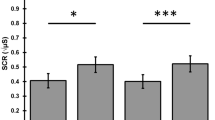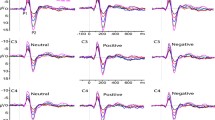Abstract
In the first half of the sixties, general notions were formulated concerning the functional role of the orienting reaction (OR) in adaptive activity, its elicitation and habituation. These notions included the following: a) The OR is elicited only by significant changes in a situation. This implies that OR elicitation is preceded by brain processes (usually unconscious) pertaining to the evaluation of the significance of changes according to an existing hierarchy of motivations, attitudes, and goals. Therefore, the OR is of an active (vs. reactive) nature, i.e., is inevitably determined by internal factors of brain activity. b) The OR is not a unitary reaction, but a complex polyfunctional activity, different aspects of which are reflected in different OR components which can be modified rather independently. c) The OR represents the processes of organizing new (non-standard) actions: sensory, motor, or intellectual. OR habituation is a manifestation of attenuation of the active control of an action, and an increase in its automation. Thus, the emphasis in understanding the OR has shifted from a predominantly “sensualistic” platform to a predominantly “actualistic” one.
In recent experiments, the role of emotional processes in the elicitation and habituation of components of the OR has been analyzed. Complex relations between the GSR and anxiety were found in a study of patients with acute alcohol withdrawal syndrome treated with different psychopharmacological agents. The study of auditory evoked potential habituation in depressive patients has shown the emotional state influence on sensory aspects of the OR with the participation of the OR brain mechanisms in perceptual defense. The possible significance of some new ideas from the field of non-linear dynamics for perspectives on future investigations of the OR are discussed.
Similar content being viewed by others
References
Barry, R. J. (1982) Novelty and significance effects on fractionation of phasic OR measures: A synthesis with traditional OR theory.Psychophysiology, 19 28–35.
Berlyne, D. E., and McDonnel, P. (1965) Effect of stimulus complexity and incongruity on duration of EEG desynchronization.Electroencephalography and Clinical Neurophysiology, 18, 156–161.
Bernstein, A. S., and Taylor, K. W. (1979) The interaction of stimulus information with stimulus significance in eliciting the skin conductance orienting response. In H. D. Kimmel, E. H. van Olst, and F. Orlebeke (Eds.),The Orienting Reflex in Humans. Hillsdale, NJ: Erlbaum.
Bernstein, N. A. (1966)Essays in the Physiology of Movements and Physiology of Activity. Moscow: Medicine Publishing House (in Russian).
Buchsbaum, M. S., Haier, R. J., and Johnson, J. (1983) Augmenting and reducing: Individual differences in evoked potentials. In A. Gale and J. A. Edwards (Eds.),Physiological Correlates of Human Behavior, Vol. 3. London: Academic Press, 117–138.
Danilin, V. P., Krylov, E. N., Latash, L. P., Magalif, A. Yu., and Rait, M. L. (1984) Some aspects of the psychophysiology of alcohol withdrawal syndrome. InSomatic and Neurologic Aspects of Alcoholism and Alcohol Psychoses. Collection of Papers. Moscow: Moscow Psychiatric Research Institute (in Russian).
Glaser, E. M., and Ruchkin, D. S. (1976)Principles of Neurobiological Signal Analysis. New York: Academic Press.
Grashchenkov, N. I., and Latash, L. P. (1963) On the active character of the orienting reaction. InBrain Reflexes. Abstracts of International Symposium. Moscow: The USSR Academy of Sciences.
Grashchenkov, N. I., and Latash, L. P. (1965) Role of orienting reaction in organizing for action.Voprosy psikhologii (Problems of Psychology), No. 1, 21–41. (in Russian).
Kochubey, B. I. (1985) Effects of the genotype and the environment on peculiarities of the orienting reaction in human individuals.Pavlov Journal of Higher Nervous Activity, 35, 428–434. (in Russian).
Koukkou, M., and Lehmann, D. (1983) Dreaming: The functional state-shift hypothesis. A neurophysiological model.British Journal of Psychiatry, 142, 221–231.
Latash, L. P. (1968)Hypothalamus, Adaptive Activity, and Electroencephalogram. Moscow: Nauka (Science) Publishing House (in Russian).
Latash, L. P. (1984) On neurophysiology of conscious awareness. In press.
Latash, L. P., Fishman, M. N., and Dallakyan, I. G. (1974) Some signs of the activity of emotional motivation mechanisms and their correlation with the processes of the organization of action. In K. Goldwurm (ed.),The First International Congress on Higher Nervous Activity. Milan, October 18–20, 1968. Pisa: Pacini.
Lehmann, D., Ozaki, H., and Pal, I. (1987) EEG alpha map series: Brain microstate by space-oriented adaptive segmentation.Electroencephalography and Clinical Neurophysiology, 67, 271–288.
Loginov, V. V., Leshchinskaya, I. P., and Latash, L. P. (1987a) Habituation of auditory evoked potentials and emotional state.Pavlov Journal of Higher Nervous Activity, 37, 414–421 (in Russian).
Loginov, V. V., Leshchinskaya, I. P., and Latash, L. P. (1987 b) EEG of interstimuli intervals during the process of habituation of auditory evoked potentials in depressives.Pavlov Journal of Higher Nervous Activity, 37, 866–874 (in Russian).
Maltzman, I. (1979) Orienting reflexes and significance: A reply to O’Gorman.Psychophysiology, 16, 274–282.
Mayer-Kress, G. (ed.) (1986)Dimension and entropies in chaotic systems. New York: Springer, pp. 231–256.
Morrell, L. K. (1966) Some characteristics of stimulus provoked alpha activity.Electroencephalography and Clinical Neurophysiology, 21, 552–561.
Mulholland, T., and Runnals, S. (1962) Increased occurrence of EEG alpha during increased attention.Journal of Psychology, 54, 317–330.
Neisser, U. (1976)Cognition and Reality. San Francisco: Freeman.
Osovets, S. M., Ginzburg, D. A., Gurfinkel, V. S., Zenkov, L. R., Latash, L. P., Malkin, V. B., Mei’nichuk, P. V., and Pasternak, E. B. (1983) Electrical activity of the brain: Mechanisms and interpretation.Uspekhi fisicheskikh nauk, 141 103–150 (in Russian; issued in English by American Institute of Physics, 1984,Soviet Physics Usp., 26, 801–828).
Packer, J. S., and Siddle, D. A. T. (1987) The effects of signal value on short- and long-term habituation.Biological Psychology, 24, 261–273.
Popper, K., and Eccles, J.C. (1978)The Self and Its Brain. Berlin: Springer.
Sokolov, E. N. (1960) Neuronal models and the orienting reflex. In M. A. B. Brazier (Ed.),The Central Nervous System and Behavior. New York: Josiah Macy, Jr. Foundation.
Sokolov, E. N. (1963)Perception and the Conditioned Reflex. New York: MacMillan.
Author information
Authors and Affiliations
Additional information
With a Comment by E. N. Sokolov
Rights and permissions
About this article
Cite this article
Latash, L.P. Orienting reaction, organizing for action, and emotional processes. Pav. J. Biol. Sci. 25, 123–131 (1990). https://doi.org/10.1007/BF02974266
Issue Date:
DOI: https://doi.org/10.1007/BF02974266




